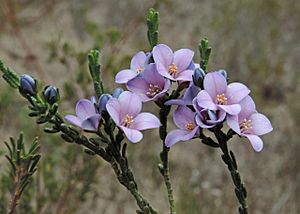Blue boronia facts for kids
Quick facts for kids Blue boronia |
|
|---|---|
 |
|
| Boronia coerulescens in the Little Desert National Park | |
| Scientific classification | |
 |
|
| Occurrence data from Australasian Virtual Herbarium |
The Blue Boronia (Boronia coerulescens) is a beautiful plant found only in southern Australia. It belongs to the citrus family, called Rutaceae. This plant is a small, thin shrub. It has special stems that feel a bit bumpy (glandular). Its leaves are small and shaped like cylinders. The flowers are usually blue, but can also be pink or purple. Each flower has four petals.
There are three types, or subspecies, of Blue Boronia. Two types grow only in Western Australia. The third type grows in Western Australia and three states in eastern Australia.
Contents
What Does Blue Boronia Look Like?
The Blue Boronia is a shrub that stands upright. It usually grows to be about 0.2–0.6 m (0.7–2 ft) tall. Its small branches have tiny, warty bumps on them.
Its leaves are usually simple, meaning they are not divided. Sometimes, they can have three small parts. The leaves are mostly shaped like cylinders, or they can be narrow and oval. They are about 5–10 mm (0.20–0.39 in) long and 0.5–1.5 mm (0.020–0.059 in) wide.
The flowers are bright blue, lilac-coloured, or white. They grow either one by one where a leaf joins the stem (called a leaf axil). Or, they can grow in thick, leafy spikes at the ends of the branches. Each flower sits on a small stalk called a pedicel, which is 2–5 mm (0.08–0.2 in) long.
Each flower has four sepals, which are like small leaves that protect the bud. These sepals are triangular or egg-shaped. They are 1.5–7 mm (0.06–0.3 in) long and overlap at their bases. The four petals are also egg-shaped with a small, pointed tip. They are 3–9 mm (0.1–0.4 in) long and overlap too.
Inside the flower, there are eight stamens (which make pollen) and a style (part of the female reproductive organ). These parts are slightly hairy. Blue Boronia usually flowers from August to November. After flowering, it produces small fruits that are 3–4 mm (0.12–0.16 in) long. The petals often stay attached to the fruit.
Naming the Blue Boronia
The scientific name for Blue Boronia, Boronia coerulescens, was first officially described in 1854. This was done by a scientist named Ferdinand von Mueller. He published his description in a scientific journal.
The second part of its name, coerulescens, comes from a Latin word. Caeruleus means "sky blue." The ending -escens means "beginning of" or "becoming." So, the name hints at its beautiful blue color.
Different Types of Blue Boronia
There are three recognized subspecies of Blue Boronia:
- Boronia coerulescens subsp. coerulescens: This type has its flowers growing in the leaf axils.
- Boronia coerulescens subsp. spicata: This type has its flowers growing in dense, leafy, spike-like clusters called racemes.
- Boronia coerulescens subsp. spinescens: This subspecies was first described in 1863. It can look different from plant to plant. It often has branches that spread out and can feel sharp. It is similar to subspecies coerulescens.
Where Does Blue Boronia Grow?
Blue Boronia typically grows in a type of forest called mallee woodland.
Subspecies coerulescens is found in the south-west part of Western Australia. It also grows in South Australia, Victoria, and the very south-west of New South Wales.
Subspecies spicata grows in Western Australia, in areas between Wubin and Muntadgin. Subspecies spinescens is found in similar areas to subspecies coerulescens, but only in Western Australia.
Is Blue Boronia Protected?
All three subspecies of B. coerulescens are considered "not threatened." This classification is given by the Western Australian Government's Department of Parks and Wildlife. This means they are not currently at risk of disappearing.

